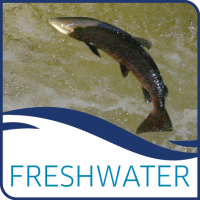The Girnock and Baddoch catchments are long-term monitoring sites where the population dynamics of spring salmon have been assessed since 1966 and 1988 respectively. These long-term monitoring sites consist of a pair of fixed traps designed to catch emigrating juvenile salmon and returning adults. Trap protocols were similar, although not identical, over the monitoring period.
Data and Resources
- Girnock and Baddoch: Adult Return Ratescsv
Column Descriptions/Units:
Year of Sea Entry – Year that fish would...
Preview Download
| Field | Value |
|---|---|
| Publisher | |
| Modified | 2025-01-30 |
| Release Date | 2015-03-20 |
| Identifier | d7290801-3ee5-49cf-bced-01d9cbf95e5a |
| Spatial / Geographical Coverage Area | POLYGON ((-3.9749650284648 56.999421062986, -3.9749650284648 57.485980881718, -2.994333319366 57.485980881718, -2.994333319366 56.999421062986)) |
| Spatial / Geographical Coverage Location | Girnock and Baddoch catchments , Scotland |
| Temporal Coverage | 1966-01-01 |
| Language | English (United Kingdom) |
| License | UK Open Government Licence (OGL) |
| Granularity | Annual |
| Author | |
| Data Dictionary | Adult return rates are expressed as a ratio of returning adult female salmon to live juvenile emigrants released at the trap site (smolts and parr). The numbers, sex and ages of returning adult Atlantic salmon were recorded at the Girnock and Baddoch traps since 1966 and 1988 respectively. Juvenile salmon are caught in the descending emigrant traps at the Girnock and Baddoch Burns in autumn and spring. Adults were lagged to their respective year of emigration based on scale read sea ages, and counts of autumn emigrants were positively lagged by one year to reflect entry to seawater and the start of adult growth. Both adult and juvenile data were the focus of a detailed validation and correction procedure carried out between 2013 and 2014. The adult and smolt data at the Girnock and Baddoch are considered to be robust and have been collected in a similar way, with a similar level of effort over the monitoring period. Counts of autumn emigrants were affected by low trap effort at the Girnock in a few years in the 1980s. Counts from some of these years have been corrected for effort (see Bacon et al. for details), other years were affected by such low effort that they are considered unusable and adult return rates for these years have been removed from the dataset. Return rates are shown for emigrant years where all adults in the expected age range of 1 to 3SW could have returned. For full details of the data and the correction process, see Bacon PJ, Malcolm IA, Fryer RJ, Glover RS, Millar CP, and Youngson AF. 2015. Can conservation stocking enhance juvenile emigrant production in wild Atlantic Salmon (Salmo salar)? Transactions of the American Fisheries Society 144(3): 642-654 |
| Contact Name | Marine Scotland Science Enquiries |
| Contact Email | |
| Public Access Level | Public |


